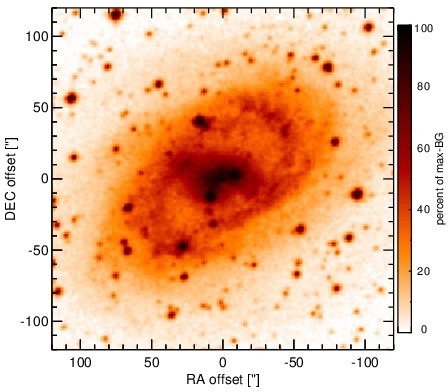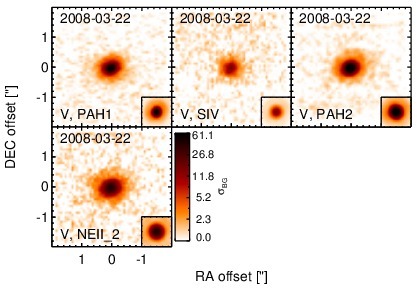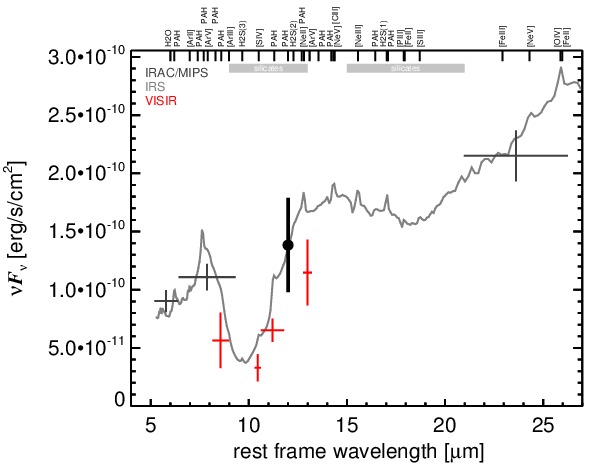Sasmirala Individual Information for NGC 6300
Description
NGC 6300 is a low-inclined barred spiral galaxy at a low Galactic latitude and a distance of D = 14.3 ± 3.3 Mpc (NED redshift-independent median) hosting a Sy 2 nucleus [veron-cetty_catalogue_2010]. It features a slightly resolved radio core at arcsecond resolution with extension in southern direction (PA~ 190∘; [morganti_radio_1999]) and water maser emission [greenhill_discovery_2003]. After IRAS, NGC 6300 was observed with ISO [bendo_infrared_2002] and Spitzer/IRAC, IRS and MIPS. The corresponding IRAC and MIPS images show a compact nucleus surrounded by spiral-like host emission and a few foreground stars, which are brightest at shortest wavelengths. The IRS LR staring-mode spectrum exhibits deep silicate 10 and 18 μm absorption, very weak PAH emission, and a steep red spectral slope in νFν-space (see also [goulding_towards_2009, pereira-santaella_mid-infrared_2010]). Thus, the arcsecond-scale MIR SED does not appear to be affected by significant star formation. We observed the nuclear region of NGC 6300 with VISIR in four narrow N-band filters in 2008 (partly published in [gandhi_resolving_2009]), and detected an elongated nucleus (FWHM(major axis)~ 0.46arcsec ~ 32 pc; PA~ 111∘) without further host emission in all images. However, at least a second epoch of subarcsecond MIR imaging is required to verify this morphology. The nuclear photometry is on average ~ 37% lower than the Spitzer spectrophotometry and exhibits the same silicate 10 μm absorption depth. Therefore, the silicate absorption originates in the projected central ~ 25 pc of NGC 6300, and we use the IRS spectrum to compute the 12 μm continuum emission estimate corrected for the silicate feature.
- [bendo_infrared_2002] George J. Bendo, Robert D. Joseph, Martyn Wells, Pascal Gallais, Martin Haas, Ana M. Heras, Ulrich Klaas, René J. Laureijs, Kieron Leech, Dietrich Lemke, Leo Metcalfe, Michael Rowan-Robinson, Bernhard Schulz, and Charles Telesco. An infrared space observatory atlas of bright spiral galaxies . AJ , 123 pp. 3067–3107, June 2002.
- [gandhi_resolving_2009] P. Gandhi, H. Horst, A. Smette, S. Hönig, A. Comastri, R. Gilli, C. Vignali, and W. Duschl. Resolving the mid-infrared cores of local seyferts . A&A , 502 pp. 457–472, August 2009.
- [goulding_towards_2009] A. D. Goulding and D. M. Alexander. Towards a complete census of AGN in nearby galaxies: a large population of optically unidentified AGN . MNRAS , 398 pp. 1165–1193, September 2009.
- [greenhill_discovery_2003] L. J. Greenhill, P. T. Kondratko, J. E. J. Lovell, T. B. H. Kuiper, J. M. Moran, D. L. Jauncey, and G. P. Baines. The discovery of H2O maser emission in seven active galactic nuclei and at high velocities in the circinus galaxy . ApJL , 582 pp. L11–L14, January 2003.
- [morganti_radio_1999] R. Morganti, Z. I. Tsvetanov, J. Gallimore, and M. G. Allen. Radio continuum morphology of southern seyfert galaxies . A&AS , 137 pp. 457–471, June 1999.
- [pereira-santaella_mid-infrared_2010] Miguel Pereira-Santaella, Aleksandar M. Diamond-Stanic, Almudena Alonso-Herrero, and George H. Rieke. The mid-infrared high-ionization lines from active galactic nuclei and star-forming galaxies . ApJ , 725 pp. 2270–2280, December 2010.
- [veron-cetty_catalogue_2010] M.-P. Véron-Cetty and P. Véron. A catalogue of quasars and active nuclei: 13th edition . A&A , 518 pp. 10, July 2010.
Images

Optical image (DSS, red filter). Displayed are the central 4 arcmin with North being up and East to the left. The colour scaling is linear with white corresponding to the median background (BG) and black to the 0.01% pixels with the highest intensity.

Spitzer MIR images. Displayed are the inner 40 arcsec with North being up and East to the left. The colour scaling is logarithmic with white corresponding to median BG and black to the 0.1% pixels with the highest intensity. The label in the bottom left states instrument and central wavelength of the filter in micron (I: IRAC, M: MIPS).

Subarcsecond-resolution MIR images sorted by increasing filter central wavelength. Displayed are the inner 4 arcsec with North being up and East to the left. The colour scaling is logarithmic with white corresponding to median BG and black to the 75% of the highest intensity of all images in units of sig_bg. The inset image (where present; either bottom or top right) shows the central arcsecond of the PSF from the calibrator star, scaled to match the science target. The labels in the bottom left state instrument and filter names (C: COMICS, M: Michelle, T: T-ReCS, V: VISIR).
SEDs


MIR SED. The description of the symbols in all the SED plots (where present) is the following: Grey crosses and solid lines mark the Spitzer/IRAC, MIPS and IRS data. The colour coding of the other symbols is as follows: green for COMICS, magenta for Michelle, blue for T-ReCS and red for VISIR data. Darker-coloured solid lines mark spectra of the corresponding instrument. The black filled circles mark the nuclear 12 and 18 micron continuum emission estimate from the data (where present). The ticks on the top axis mark positions of common MIR emission lines, while the light grey horizontal bars mark wavelength ranges affected by the silicate 10 and 18 micron features.